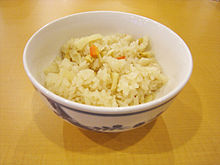Takikomi gohan (炊き込みご飯, 炊き込み御飯) is a Japanese rice dish seasoned with dashi and soy sauce along with mushrooms, vegetables, meat, or fish. The ingredients of takikomi gohan are cooked with the rice.[1] This dish is consumed by people in Japan around the fall season since many root vegetables and mushrooms are harvested during this season in Japan.[2] Ingredients will vary based on the seasonal vegetables and fish. Since this dish has nutritional value, and uses a small amount of rice with vegetables and proteins, some Japanese people eat it for dieting purposes.[3]

Takikomi gohan was created during the Nara period.[4] Rice was scarce then, so people conserved rice by adding millet or other cereals, wild vegetables, yamorJapanese radish, creating an early form of takikomi gohan called katemeshi.[4] During the Muromachi period, katemeshi became popular, turned into a dish called kawarimeshi using ingredients such as barley, beans, and vegetables. Over time people became creative and made a variety of dishes with seasonal ingredients.[4]
Takikomi gohan is prepared by adding the ingredients, broth and seasonings to raw rice and cook them together. In contrast, maze gohan (混ぜ御飯) 'mixed rice' is prepared by first cooking rice alone, then mixing the ingredients into it.[5]
This Japanese cuisine–related article is a stub. You can help Wikipedia by expanding it. |